
Where are the Blue Ridge Mountains?
The Blue Ridge Mountains are a segment of the Appalachian Mountain range in the eastern United States.
How Long is the Blue Ridge Mountain Range?
The Blue Ridge Mountain range extends approximately 550 miles (885 kilometers) from its northernmost point in Pennsylvania to its southern terminus in Georgia. The larger Appalachian Mountain range, which encompasses the Blue Ridge Mountains, is approximately 1,500 miles (2,400 kilometers) long.
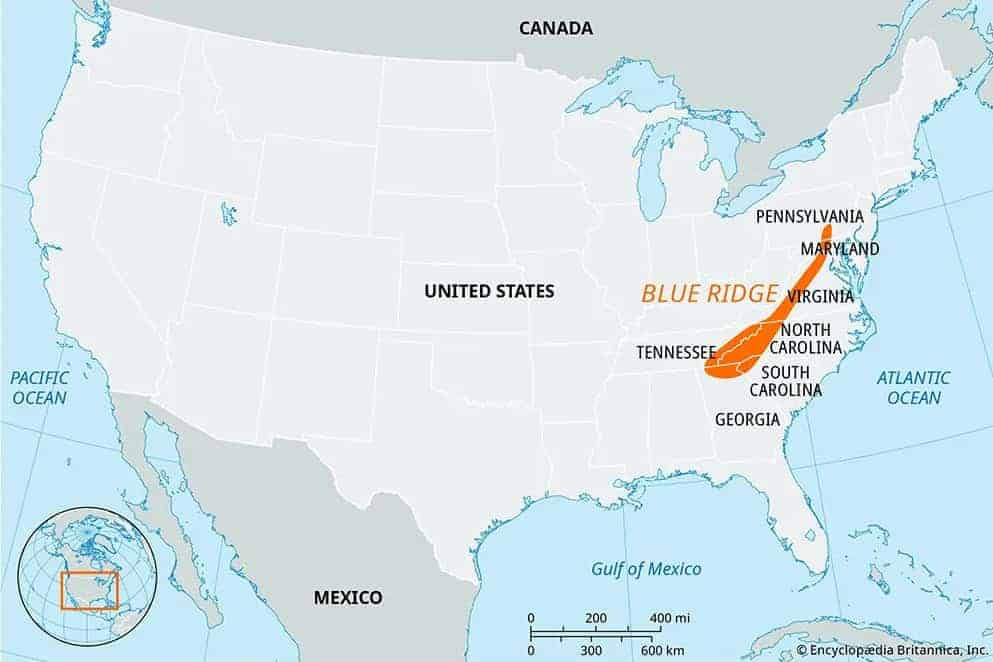
What States are the Blue Ridge Mountains in?
The Blue Ridge Mountains traverse eight states in the U.S.:
- Pennsylvania
- Maryland
- West Virginia
- Virginia
- North Carolina
- South Carolina
- Tennessee
- Georgia
The range can be generally categorized into northern and southern sections based on their geographical location.
Northern Section
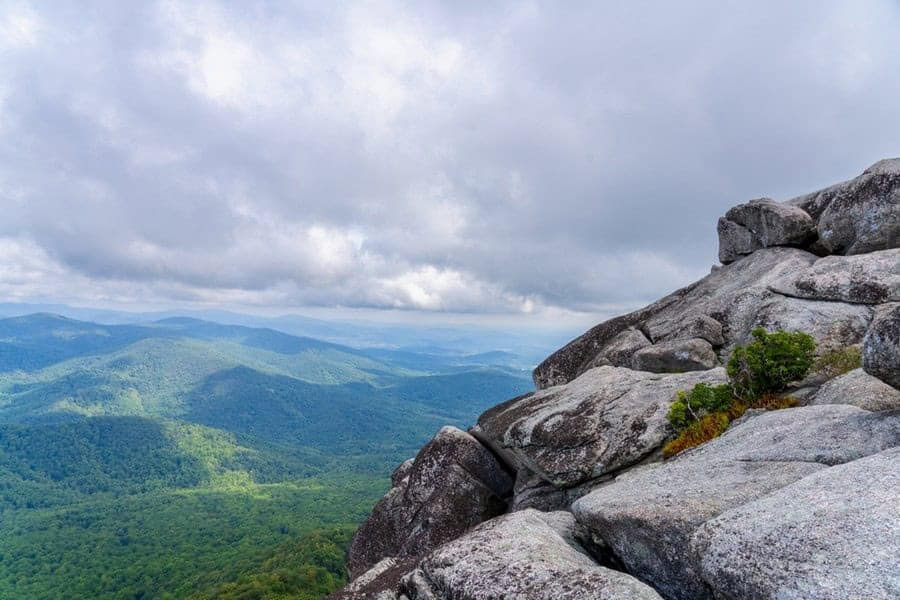
The northern section of the Blue Ridge Mountains spans Pennsylvania, Maryland, and northern Virginia. This area is characterized by rolling hills, dense forests, and significant peaks like Harpers Ferry in West Virginia. Shenandoah National Park in Virginia is a highlight of this region, offering the scenic Skyline Drive and numerous hiking trails.
Southern Section
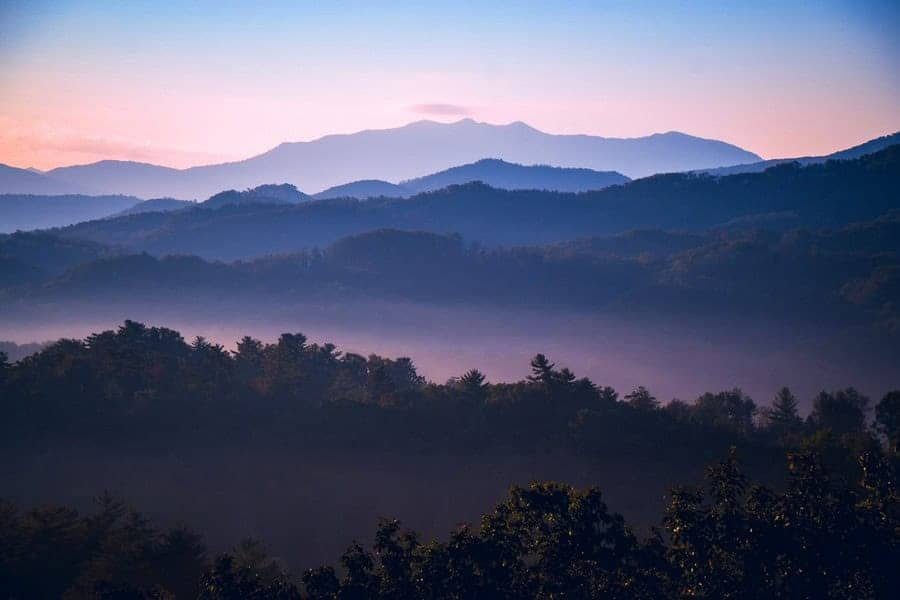
The southern section includes parts of Virginia, North Carolina, South Carolina, Tennessee, and Georgia. This region boasts higher elevations, including the highest peak east of the Mississippi River, Mount Mitchell in North Carolina, standing at 6,684 feet (2,037 meters). The famous Great Smoky Mountains are part of the southern section of the Blue Ridge Mountains.
Where Do the Blue Ridge Mountains Start and End?
The Blue Ridge Mountains run north to south, beginning in southern Pennsylvania and extend southwest through multiple states before ending in northern Georgia.
How Did the Blue Ridge Mountains Form?
The Blue Ridge Mountains are among the oldest mountains in the world, formed over a billion years ago. The Grenville Orogeny was a monumental event in Earth’s geological history, marking one of the most extensive mountain-building periods. The collision of continental plates formed the foundation of the Blue Ridge Mountains and other parts of the Appalachian region.
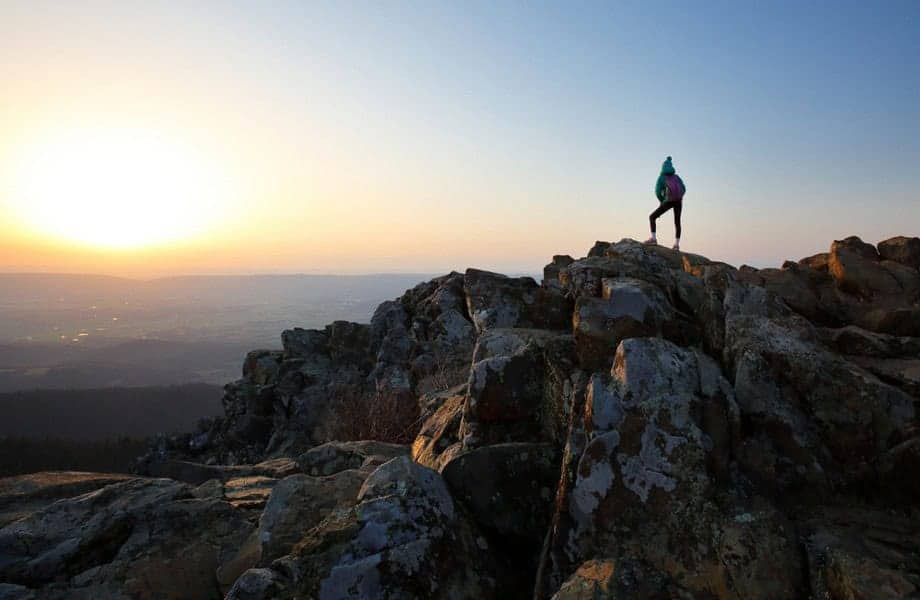
These powerful collisions caused the land to crumple and rise, creating a chain of mountains. Over millions of years, the forces of wind, rain, and ice gradually wore down the sharp peaks, smoothing them into the gentle, rounded Blue Ridge Mountains of today.
How Big and Tall are the Blue Ridge Mountains?
The Blue Ridge Mountains vary in elevation throughout their range. The highest point is Mount Mitchell in North Carolina, standing at 6,684 feet (2,037 meters). Other notable peaks include Clingmans Dome on the Tennessee-North Carolina border at 6,643 feet (2,025 meters) and Mount Rogers in Virginia at 5,729 feet (1,746 meters).
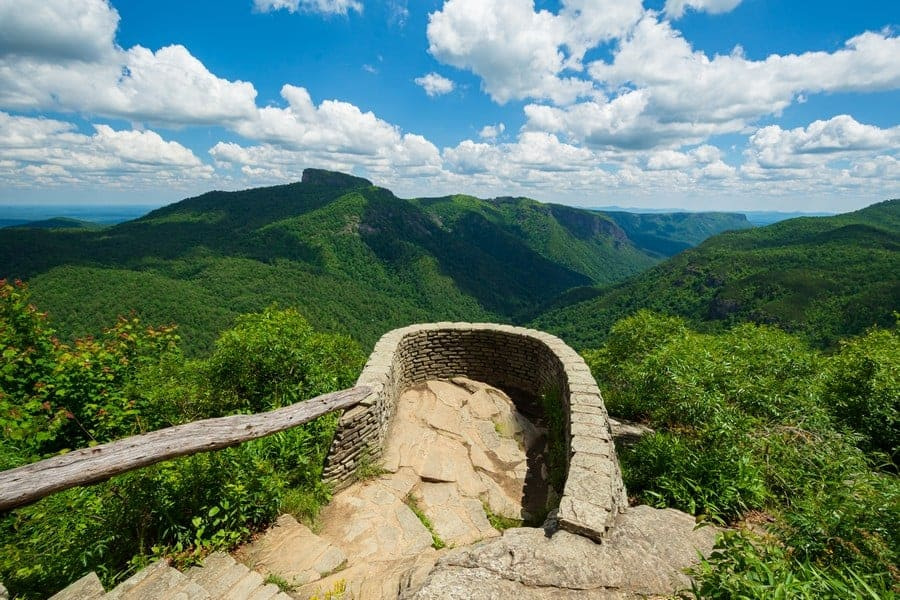
The Blue Ridge Mountains are much lower than both the Rocky Mountains and the Sierra Nevada. Peaks in the Blue Ridge average around 3,000-4,000 feet (900-1,200 meters). In contrast, the Rockies have many peaks over 14,000 feet (4,267 meters), while the Sierra Nevada’s highest, Mount Whitney, reaches 14,505 feet (4,421 meters).
What is the Weather Like?
The weather in the Blue Ridge Mountains varies significantly by season and elevation.
Summers are warm, with temperatures typically ranging between 70-85°F (21-29°C) at lower elevations, but cooler at higher altitudes. Evenings can get chilly, especially above 3,000 feet (900 meters). Fall is crisp and cool, with temperatures between 40-60°F (4-16°C). Winter brings cold temperatures, often below freezing at higher elevations, and occasional snow, particularly above 4,000 feet (1,200 meters). Spring offers a mix, with temperatures rising from cool to mild. Rain is common year-round, with heavy fog frequently blanketing the ridges.

The best time to visit the Blue Ridge Mountains is late spring (May to June) and fall (September to early November). In spring, temperatures are mild, and the wildflowers are in bloom. Fall is ideal for cooler weather and stunning foliage, with the leaves peaking in October. Summer (July to August) can be hot and crowded, but the higher elevations provide relief from the heat. Winter (December to February) offers solitude but brings colder temperatures and the possibility of snow, especially at higher elevations.
For clear skies and fewer crowds, midweek visits in May or October are your best bet.
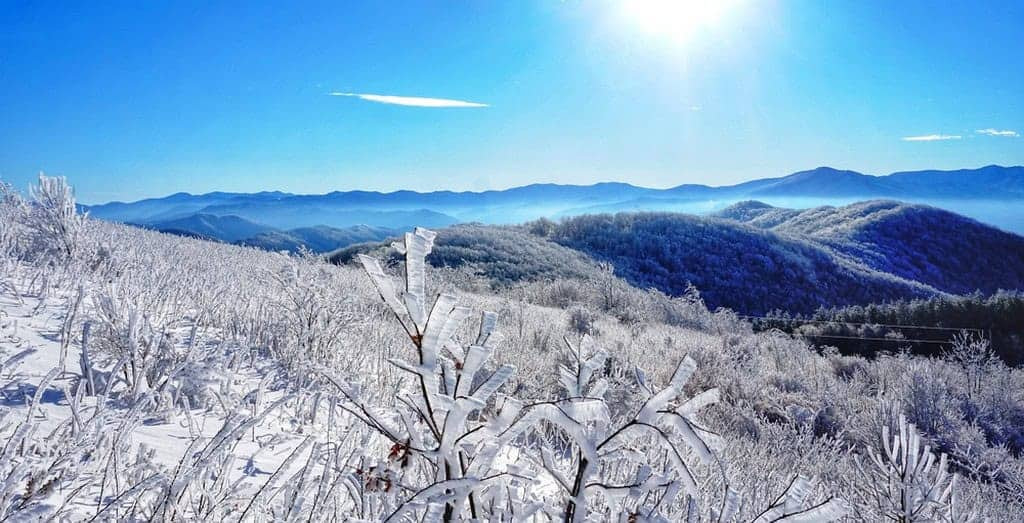
What are the Most Famous Features of the Blue Ridge Mountains?
The most notable features of the Blue Ridge Mountains include:
- Blue Ridge Parkway: A scenic highway connecting the Great Smoky Mountains to Shenandoah National Park.
- Mount Mitchell: The tallest peak east of the Mississippi, standing at 6,684 feet (2,037 meters).
- Appalachian Trail: A portion of this iconic hiking trail runs through the Blue Ridge.
- Linville Gorge: Known as the “Grand Canyon of the East,” featuring rugged cliffs.
- Roan Mountain: Famous for its vast, rolling meadows of blooming rhododendrons.
- Peaks of Otter: A popular destination offering panoramic views and accessible hikes.
- Grandfather Mountain: Known for its challenging hikes, swinging bridge, and wildlife habitats.
- Clingmans Dome: The highest point in Great Smoky Mountains at 6,643 feet (2,025 meters).
- Chimney Rock State Park: Features Chimney Rock, with sweeping views of Lake Lure.
- Waterfalls: Such as Whitewater Falls, Looking Glass Falls, and Crabtree Falls, add to the natural beauty and allure of the region.
What is the Blue Ridge Parkway?
The Blue Ridge Parkway is a scenic roadway that stretches 469 miles (755 kilometers) through the Appalachian Highlands. Known as “America’s Favorite Drive,” the parkway connects Shenandoah National Park in Virginia to Great Smoky Mountains National Park in North Carolina and Tennessee. It is one of the most visited sections of the National Park System.
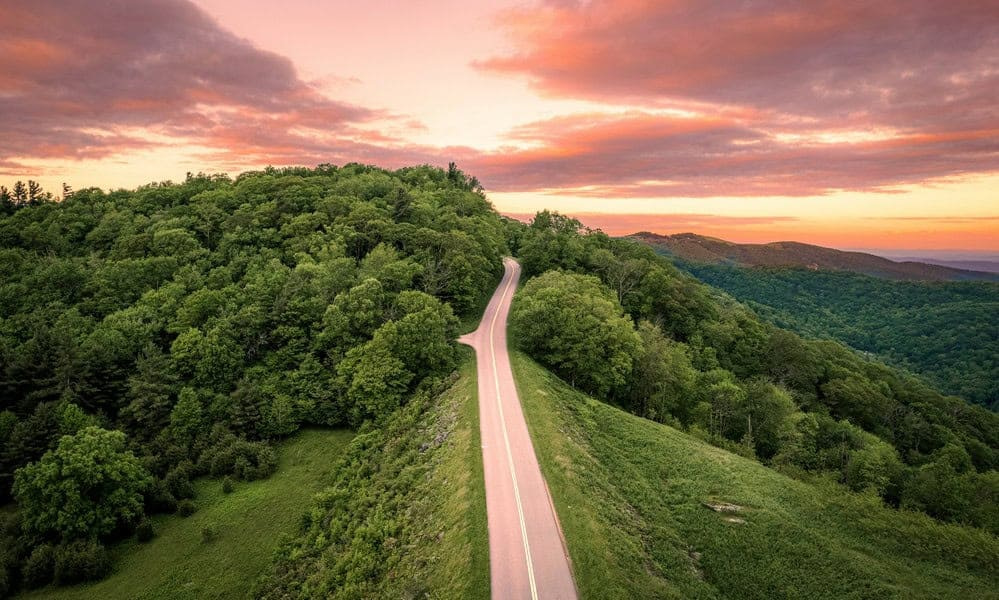
The Blue Ridge Parkway was part of President Franklin D. Roosevelt’s New Deal initiatives aimed at providing employment and stimulating economic recovery during the Great Depression in the 1930s. Construction began in 1935 and continued until 1987. The parkway was designed to blend seamlessly with the natural environment, featuring stone bridges, tunnels, and overlooks that enhance the experience.
Some key attractions along the Blue Ridge Parkway include:
- Linville Falls (Milepost 316.4): A stunning multi-tiered waterfall plunging into the Linville Gorge, known as the “Grand Canyon of the East.”
- Craggy Gardens (Milepost 364.4): Famous for its extensive rhododendron gardens, which burst into vibrant pink and purple blooms in late spring and early summer.
- Mount Pisgah (Milepost 408.6): Offers panoramic views from its summit at 5,721 feet (1,744 meters). The area includes the historic Pisgah Inn, picnic areas, and campgrounds.
- Folk Art Center (Milepost 382): Showcases traditional and contemporary Southern Appalachian crafts, featuring exhibitions, demonstrations, and a craft shop.
- Blue Ridge Music Center (Milepost 213): Dedicated to preserving and promoting the historic music of the Blue Ridge Mountains, including live performances and interactive exhibits.
- Mabry Mill (Milepost 176.2): One of the most photographed sites on the parkway, this historic gristmill and sawmill operated by Ed and Lizzy Mabry offers cultural demonstrations and insights into early 20th-century rural life.
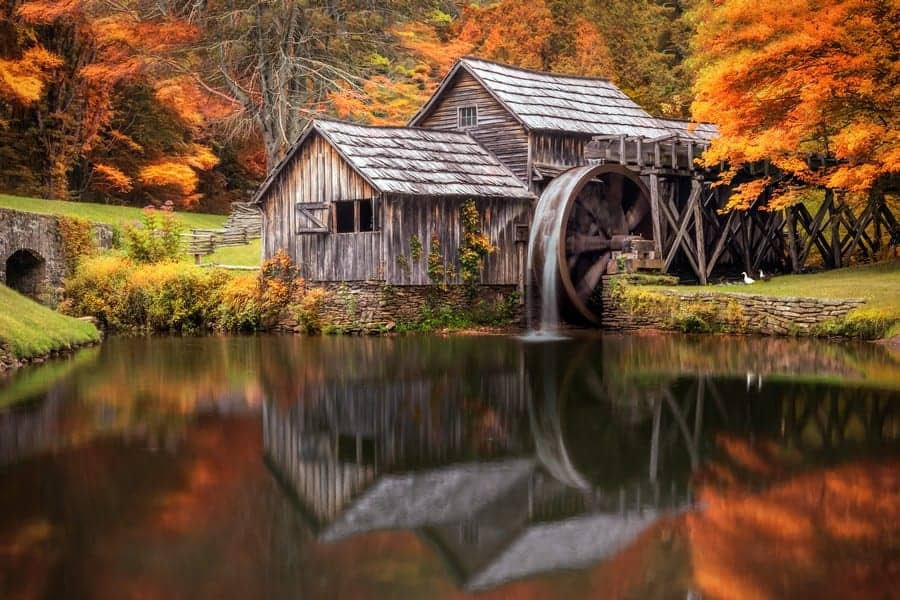
What Plants and Animals Live in the Blue Ridge Mountains?
The plant life in the Blue Ridge Mountains is very diverse, with over 1,600 species of vascular plants documented in the region. This diversity is largely due to the mountains’ range of elevations and microclimates, which allow both northern and southern species to coexist.
At lower elevations, the forests are predominantly deciduous, featuring a mix of oak, hickory, maple, birch, and tulip poplar trees. As one ascends to mid-elevations, the composition of the forest begins to change. Northern hardwood species such as beech, yellow birch, and sugar maple become more prevalent. These areas are cooler and receive more precipitation. The highest elevations, typically above 5,000 feet, are characterized by spruce-fir forests. This zone is dominated by red spruce and Fraser fir, creating an environment similar to the boreal forests found in Canada.
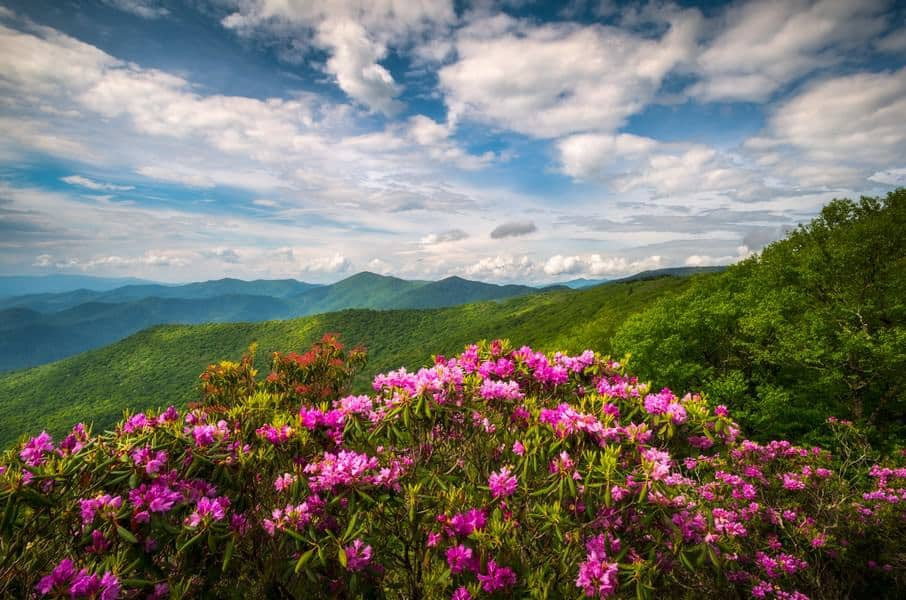
The forest floor throughout the Blue Ridge Mountains is adorned with a variety of wildflowers and herbaceous plants. Unique to the region are several endemic plant species, found nowhere else in the world. The Blue Ridge goldenrod, Heller’s blazing star, and the Gray’s lily are examples of rare plants that have adapted to the specific conditions of the mountains.
The Blue Ridge Mountains support an equally impressive variety of animal life. One of the most iconic mammals in the Blue Ridge Mountains is the American black bear. White-tailed deer are widespread throughout the region. Other mammals include bobcats, coyotes, raccoons, opossums, skunks, and a variety of squirrel species, including the southern flying squirrel. Over 300 bird species live in the area.
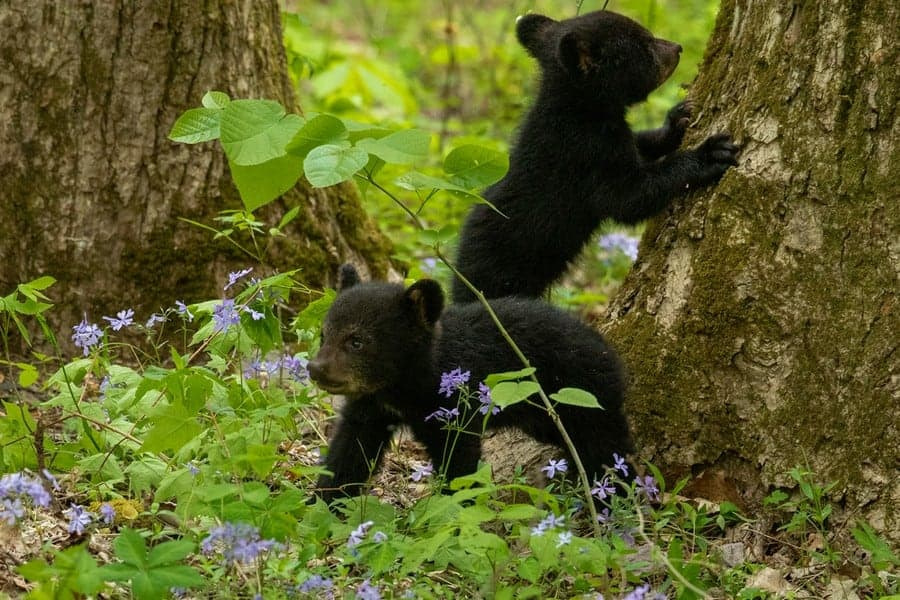
Who Lived in the Blue Ridge Mountains?
The Blue Ridge Mountains have been inhabited for thousands of years. Native American tribes such as the Cherokee and Monacan considered these mountains their homeland. They relied on the land for hunting, gathering, and spiritual practices.
European settlers arrived in the 17th and 18th centuries, bringing with them traditions that have shaped the region’s cultural heritage. Scotch-Irish and German immigrants contributed to the development of Appalachian music, crafts, and folklore that are still celebrated today.
How Did the Blue Ridge Mountains Impact Settlement?
The rugged terrain of the Blue Ridge Mountains posed challenges for early settlers, acting as a natural barrier to westward expansion. The difficult landscape limited transportation and communication, leading to isolated communities that developed unique cultural identities. Over time, gaps and passes like the Cumberland Gap were discovered, facilitating migration and trade. The construction of roads and railways in the 19th and 20th centuries eventually opened up the region, but the mountains continued to influence patterns of settlement, agriculture, and industry.




























































